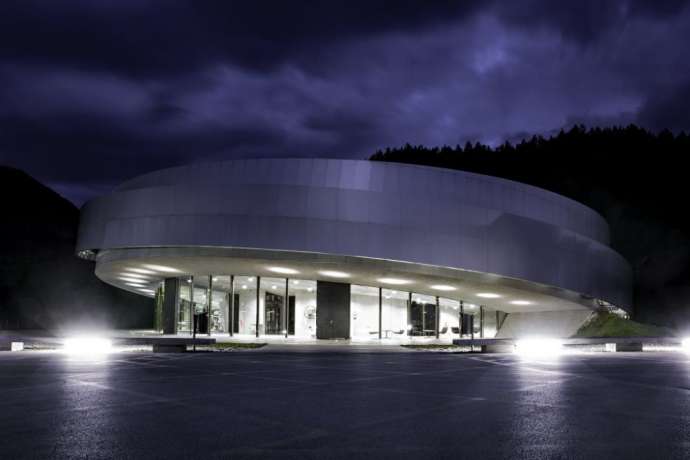April 25, 2019
On Tuesday the Noordung Centre in Vitanje hosted an event titled Noordung Forum: Building European Blockchain Infrastructure. The forum was organised by the Ministry of Economic Development and Technology, the Noordung Hub and Tolar Hashnet, a blockchain developer.
Names worth mentioning from the crowd of representatives of business and states that attended the event are certainly Tadej Slapnik, a member of the former Prime Minister Cerar’s cabinet and the cabinet of MEP Ivo Vajgl, and currently the director of Tolar Hashnet; Minister of Culture Zoran Poznič; European Commissioner for Transport Violeta Bulc; and Member of European Parliament Ivo Vajgl. The event was announced by Nena Dokuzov, Head of the Project Group for New Economy and Blockchain Technology of the Ministry of Economic Development and Technology of the Republic of Slovenia. Nena Dokuzov is also a member of the European Blockchain Partnership and a former director of the Noordung Centre, a post she took following the controversial takeover of this originally privately owned establishment by the government.
The debate focused on various hypothetical uses of blockchain, with an underlying consensus on the “ground-breaking” and “world changing” characteristics of the technology. The event then climaxed with the launch of the Tolar Hashnet TestNet, which is basically yet another coin.
This one, however, is based on “advanced” blockchain technology which is “scalable” and “100% secure”. Meaning, the system of Tolar has abandoned a classical blockchain mining component and moved towards a more efficient and therefore centralised system with just a few global nodes calculating the code chain. This allows for faster code processing and hence more daily transactions. Its capability however is still nowhere close to the functional level any means of exchange must meet in order to support the velocity of money.
Therefore, crypto currencies for now remain “digital currency schemes”, exhibiting key features such as being “assets, the value of which is determined by supply and demand, similar in concept to commodities such as gold, yet with zero intrinsic value” (BIS definition according to source, p. 21). Meaning that any returns on investment rely mostly on bringing more investors into the scheme. Of course this wouldn’t have worked, if it didn’t come with a good story, which provides its members with a sense of superiority (as the “technologically advanced” ones) and moralising tools of recruitment: saying “no” to blockchain (i.e. refusing to invest in crypto) means to be technologically uneducated and socially irresponsible, since blockchain is here to somehow bring back democracy and is also – according to Tadej Slapnik from Tolar Hashnet – environmentally friendly.
Things seem to have changed drastically since the Cultural Centre of European Space Technologies (KSEVT) was launched in Vitanje in 2012. The main emphasis of the project was not on technological advancement of space travel per se, as such a purely utilitarian stance quickly brings military-oriented goals while the function of human in space is to survive and follow protocols, hence reduced to the dilemma of Is it really a human or is it a robot?.
KSEVT’s project of space culturalization was inspired by the father of astronautics, Herman Potočnik Noordung, who spent most of his childhood in either Maribor or Vitanje, his mother’s birthplace. In 1929 Potočnik published his single but ground-breaking work The Problem of Space Travel – The Rocket Motor, in which he applied his engineering ingenuity to explore life in space from a humanistic perspective. His wheel-shaped space station inspired many to come, notably the design of the “Space Station V” in Stanley Kubrick’s 2001: A Space Odyssey.
KSEVT was well accepted not just by proud local descendants of the space travel pioneer, but also by the international space agencies and astronauts, such as Sunita Williams, who visited and participated in several of events in Vitanje.
In 2014, KSEVT was transformed from a private institute into a public municipal institute, to become eligible to apply for public funding at the national and not just municipal level and in the same year also received some funding from the Ministry of Culture. However, the Ministry was not happy with KSEVT’s report on how the money was spent, which eventually led to the government takeover. The original founders were removed, and Nena Dokuzov from the Ministry of Economic Development and Technology was named acting director.
In 2017 Nena Dokuzov established Noordung Blockchain Hub cooperative which attempted to register and operate from the Noordung Space Center in Vitanje. In early 2018 members of municipality council in Vitanje unanimously rejected Noordung Blockchain Hub’s request on the grounds that Cryptocurrencies do not have much in common with culturalization of space, the main activity of the Noordung Centre.
In 2018 Dominik Kobolt replaced Nena Dokuzov as the acting director of Noordung Space Centre. As evident from the latest events, attempts at the colonisation of cultural space by cryptocurrency salesmen continue with full support of Slovenian government officials and their representatives in the European Union.






